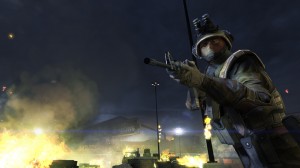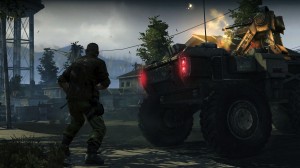Homefront Multiplayer Review (360)
- Updated: 22nd May, 2011
 After playing through and reviewing the single-player campaign, I was surprised to find a pretty robust multi-player component to Homefront. Sure, there aren’t a lot of maps but for a console FPS novice like myself it’s a serviceable enough release to keep me and a few thousand others occupied.
After playing through and reviewing the single-player campaign, I was surprised to find a pretty robust multi-player component to Homefront. Sure, there aren’t a lot of maps but for a console FPS novice like myself it’s a serviceable enough release to keep me and a few thousand others occupied.
The maps are based around levels from the single-player game and feature homegrown (if you’re American) locations such as “Cul-de-sac”, “Farm”, and “Suburb”. What I like about them is they do a pretty good job giving you a sense of place with buildings that for the most part feel like real structures, while still feeling like a good game level with choke points, etc. In all there are only eight maps but from what I can tell, they are eight good ones that – in my twelve or so hours playing multiplayer – I didn’t find I was becoming too weary of.
 Much like every game since Call of Duty Modern Warfare, there are unlocks. And the game encourages players by rewarding them for nearly everything, from saving a teammate, to getting a certain number of kills in a vehicle. Sure, the different roles don’t allow you to do much to buff the other players (there are no medics), but there’s enough slight variation to keep people interested, at least for a while.
Much like every game since Call of Duty Modern Warfare, there are unlocks. And the game encourages players by rewarding them for nearly everything, from saving a teammate, to getting a certain number of kills in a vehicle. Sure, the different roles don’t allow you to do much to buff the other players (there are no medics), but there’s enough slight variation to keep people interested, at least for a while.
Classes and Weapons
Next to the bog-standard Assault Class are the usual tropes of SMG, Heavy, Sniper, Tactical and finally Explosive (an exciting name, to be sure, but I think I would have chosen “Demolitions”, myself). In addition to a primary weapon and a sidearm, each class has two “purchase” slots for abilities and tools, which help to differentiate them, at least at first. As you spend time unlocking new abilities and options, however, you can customise each class how you see fit. There are airstrikes, UAV drones, rocket launchers, ground-based attack drones (basically a RC robot with a machinegun) and flying attack drones, as well as armour and other equipment. All of the basics for a Modern Warfare-style game, really.
One of Kaos Studios’ previous games, Frontlines: Fuel of War had some of these elements, namely the drones, and they’ve been well-integrated into Homefront. They aren’t things I really found myself using that often, as they cost “Battle Points”: the in-game currency that you earn from each battle alongside XP. It wasn’t exactly clear to me what earned me XP and what earned me BP, but as an economy it seemed to work fine. I played surprisingly competently enough and earned both whilst playing, enough to keep the progression going and the new items and abilities flowing.
Much like Modern Warfare’s “Perks” system, there are individual infantry abilities to unlock as well which, sort of confusingly, are bought with a “pool” of points different from the BP you earn to spend on the purchase slots. The abilities are tiered so there are abilities that cost up to five points while active but you only start with a small pool and only certain ones are available at the start. These are things like Quick Draw (quicker aiming down sights) and Fist Full, which give you more grenades. As you unlock more abilities they can, of course, be chopped and changed to customise your experience.
Speaking of grenades and other equipment, each weapon can have an attachment which is comprised of a variety of sights, and the special explosive can be selected, including flash bangs and C4. The weapons can also have differing camo colour schemes, which I can only assume is to make sure it matches your purse and handbag as you sprint around the battlefield. I eschewed the lowly Chrome (unlocked at a measly level 55) and went for “I <3 My Gun” (replete with pink ribbon-wearing skulls crying blood) as soon as it was unlocked, naturally.
Motors and Modes
There are vehicles, a la EA’s venerable Battlefield series. You start with the Humvee, but at higher levels, two tanks and a couple of helos are available. Alongside the infantry abilities are vehicular abilities, like Gyro (faster turret turn speed) and the enviable Big Stick (more damage). Thankfully, they are not the same lumbering beasts of limited constitution as in Battlefield games; they can’t be countered quite so easily. I didn’t find that vehicles were employed all that often and hardly used them myself, as the unlocks beyond Humvee don’t come early and each costs quite a lot of BP points beyond even their relatively longer lifespan. This game’s focus is still squarely on infantry.
 Equipment and colour schemes aren’t the only things that may be unlocked. There are entire game modes that aren’t available until you gather a couple of hours worth of XP. Initially there is just Team Deathmatch and Ground Control, which is akin to Battlefield’s “ticket” system whereby players must hold control points for a specified amount of time before scoring a point. Two points during a match equals a win. However, losing a point means that the team must fall back to a separate set of control points, which makes for an interesting tug-of-war compared to other games in the genre.
Equipment and colour schemes aren’t the only things that may be unlocked. There are entire game modes that aren’t available until you gather a couple of hours worth of XP. Initially there is just Team Deathmatch and Ground Control, which is akin to Battlefield’s “ticket” system whereby players must hold control points for a specified amount of time before scoring a point. Two points during a match equals a win. However, losing a point means that the team must fall back to a separate set of control points, which makes for an interesting tug-of-war compared to other games in the genre.
The other modes are pretty standard but one innovation is “Battle Commander”. If one player on the other team starts racking up kills and getting kill streak rewards (temporary buffs) the other team will be alerted to this by their AI “Battle Commander” and it will paint a big target on the threat’s general location. The bigger the threat, the more players on the opposing team are assigned to hunt them down. So it’s a little like when you’re causing havoc in Grand Theft Auto or Red Dead Redemption and your “wanted’ level goes up. As the target accumulates more kills, more rewards are given, which theoretically enable that player to survive the inevitable onslaught.
In Summary
At the end of the day, there isn’t necessarily enough in the multiplayer mode to warrant purchasing the game on its own merits but coupled with the relatively short single-player campaign, it’s a capable affair. I went into it not expecting very much, but came away pleasantly surprised at how capable the mode was. It’s just a shame there isn’t more on offer, or something truly unique and inspiring to make it really compelling.
Easy though the matchmaking and “I just want to get into a game” experience is, I didn’t find myself desperate to load up the game every evening to receive another dose. To put it simply, what is here has been done before, and the experience is probably just above adequate. It’s not a disappointment and will be a nice addition to anyone who purchased the game for the single-player campaign, but it’s not a centrepiece or a mainstay that really extends the life of Homefront a great deal. It’s nice to see it wonderfully executed on the 360. Unfortunately it’s nothing to write home about.
Homefront is available now on Windows, Xbox 360 and PlayStation 3


Follow Us!